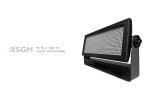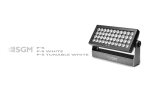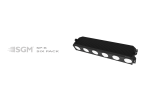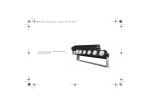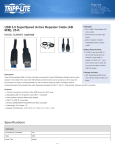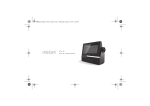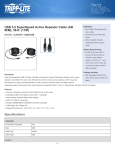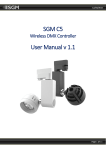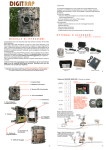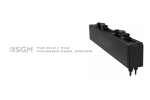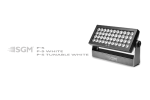Download SP∙6 SIXPACK
Transcript
SP∙6 SIXPACK SP-6 SixPack dimensions All dimensions in mm. Drawing not to scale. 2 SP-6 SIXPACK USER MANUAL REV. 4 © 2013 SGMTM. Information subject to change without notice. SGM and all affiliated companies disclaim liability for any injury, damage, direct or indirect loss, consequential or economic loss or any other loss occasioned by the use of, inability to use or reliance on the information contained in this manual. The SGM logo, the SGM name and all other trademarks in this document pertaining to services or products by SGM or its affiliates and subsidiaries are trademarks owned or licensed by SGM or its affiliates or subsidiaries. English edition 3 4 Contents Safety information.................................................................................................... 6 Overview.................................................................................................................. 8 Preparing for installation........................................................................................... 9 Installing the SP-6 SixPack................................................................................... .10 Installing fixtures at elevation in an array................................................................11 Connecting AC power............................................................................................. 16 Connecting to control data..................................................................................... 17 Configuring the device ........................................................................................... 18 Service................................................................................................................... 23 DMX protocols........................................................................................................ 24 Control menu.......................................................................................................... 31 Specifications......................................................................................................... 34 User’s notes........................................................................................................... 37 5 Safety information WARNING! Read the safety precautions in this section before installing, powering or operating this product. The SP-6 SixPack is intended for professional use only. It is not suitable for household use. Review the following safety precautions carefully before installing or operating the device. This product must be installed in accordance with the applicable installation code by a person familiar with the construction and operation of the product and the hazards involved. Ce produduit doit être installé selon le code d’installation pertinent, par une personne qui connaît bien le produit et son fonctionnement ainsi que les risques inhérents. Preventing electric shock DANGER! Risk of electric shock. Do not open the device. • • • • • 6 Do not open the device; there are no user-serviceable parts inside. Ensure that power is cut off when wiring the device to the AC mains supply. Ensure that the device is electrically connected to earth (ground). Do not apply power if the device is in any way damaged. Do not immerse the fixture in water or liquid. WARNING! Take measures to prevent burns and fire. • • • • • • • Install in a location that prevents accidental contact with the device. Install only in a well-ventilated space. Install at least 0.3 m (12 in.) away from objects to be illuminated. Do not paint, cover, or modify the device, and do not filter or mask the light. Keep all flammable materials well away from the device. Allow the device to cool for 15 minutes after operation, before touching it. Caution: Exterior surface temperature after 5 min. operation = 35˚C (91˚ F) Stady state = 70˚C (182˚ F). WARNING! Take measures to prevent personal injury. • • • • Do not look directly at the light source from close range. Take precautions to prevent injury due to falls when working at height. Ensure that the device is always securely fastened with suitable hardware. For elevated installations, secure the fixture with a suitable safety cable, and always comply with relevant load dimensioning and safety standards and requirements. 7 Overview The SP-6 SixPack is a pixel array based on the popular blinder—but the traditional halogen lamps have been replaced with RGBA LEDs. The fixture incorporates six powerful 35 W colour mixable LEDs, with individual DMX control over each pixel, enabling a creative lighting designer to paint light canvasses, display animated text or programmed patterns. The SP-6 SixPack can even emulate the decay effect of halogen lamps (tungsten response emulation). As the fixture is rectangular, groups of up to eight fixtures can be flown in vertical or horizontal arrays, which in turn can be linked together into larger matrixes. The fixture offers built-in dimming, RGBA color mixing, color temperature correction, daisychainable power and DMX, wireless configuration via RFID, and a lamp life expectancy of 50,000 hours. A Tilt locks B DMX in C Fuse holder D Power in E Safety cable eyelet F OLED display and control panel G Bracket/stand H RFID interface I DMX out cable J Gortex membrane K Power out cable 8 Preparing for installation Unpack the device and inspect it to ensure that it has not been damaged in transport. The SP-6 SixPack is supplied with this user guide, a stand bracket, a vertical-array top mounting bracket, two snap-lock brackets, a Neutrik powerCON TRUE1 power cable and two locking pins with cotter pins. The fixture is not designed for permanent outdoor installation, but it is IP65-rated. This means that it is protected from: • Dust, to the degree that there is no ingress of dust. • Lower pressure jets of water from any direction. When selecting a location for the device, ensure that it: • • Is situated away from public thoroughfares and protected from contact with people. Has adequate ventilation. 9 Installing the SP-6 Six Pack WARNING! If the device has been operating, always allow it cool for 15 minutes The SP-6 SixPack may be installed in any orientation. Using the stand bracket. The fixture is supplied with a stand bracket that can be bolted to a surface using M12 hardware, or used to fly a single fixture at elevation using clamps or similar. The bracket is not designed to support the weight of more than one fixture. The angle of the fixture can be adjusted using the tilt locks at either end of the fixture. WARNING! Always secure an elevated SP-6 SixPack with a safety cable as backup When flying any fixture at elevation, always fasten a safety cable between the load-bearing support structure and the attachment point on the device. The safety cable must be able to bear at least 10 times the weight of the device (see “Specifications” on page 41). Min. safety wire gauge = 3mm. 10 Installing fixtures at elevation in an array WARNING! Do not connect more than eight SP-6 SixPacks together in a single array Using the supplied snap-lock brackets, horizontally (flat) or vertically (upright) aligned SP-6 SixPack fixtures can be connected into arrays. The supplied hardware is able to bear the weight of up to eight SP-6 Six Pack fixtures. Arrays can be flat (rigid) or curved, as fixtures that are connected using the snap-lock connectors can be curved outwards at an angle of 29°. Always ensure that each device in an array has a safety cable connecting it to the load bearing structure, and not simply to another fixture in the array. Planning the layout of fixtures in an array Daisy-chaining is useful in that it reduces the amount of cabling required. For ease of connecting the fixtures in a power/DMX daisy-chain and to ensure a tidy uncluttered rig, we recommend that the orientation of fixtures in an array be carefully planned to enable each fixture to be connected to the next using the built-in 0.5 m (20 in.) cables. In some cases, because of the cable lengths, this will require some fixtures to be flipped over in relation to their immediately adjacent fixtures. To ensure consistency of control, these devices should have their pixel orders reversed using the “Settings→Reverse Pixel Order→Reversed” menu (see “Reversing the fixture pixel order” on page 21). To flip the display, see “Flipping the OLED display” on page 21. 11 Attaching snap-lock brackets Two snap lock brackets are supplied with each fixture and these are used to connect fixtures together in arrays. 1 To remove the stand bracket and mount the snap-lock brackets: 1. Unscrew the tilt locks on each side of the fixture and detach the stand. 2. Remove the two Torx 25 screws that hold the safety cable eyelet in place and remove the eyelet. 3. Attach the snap lock brackets as shown, so that the male and female parts are placed at opposite ends. 2 3 12 Connecting vertically-oriented SP-6 Six Packs into an array thread Up to eight vertically-aligned (upright) SP-6 SixPacks can be connected using the supplied locking pins inserted through the eye holes on the snap-lock brackets. The device at the top of a vertically-aligned array thread must always be flown using a vertical-array top mounting bracket (supplied with the fixture) that is attached to a G-clamp or suitable mounting hardware, and secured to a structure dimensioned to bear the load. We recommend that this top fixture be oriented to enable it to be daisy chained to one of its neighbours using the built-in DMX and power cables (see “Planning the layout of fixtures in an array” on page 11). If the array is to be curved along the vertical plane, then only one locking pin is required at each end. To achieve a flat, rigid array, insert locking pins in both holes. To connect one vertically-oriented SP-6 SixPack device to another: 1. Lift a SP-6 SixPack into position under the other so that the eye holes on each fixture are aligned. Orient the fixture so that the built-in DMX and power patch cables and connectors are able to reach, or be reached, by adjacent devices in a daisy chain. 2. Insert one (for curved array) or two (for flat array) of the supplied locking pins into the holes and secure them using the cotter pins. 13 Connecting a stack of horizontally-oriented SP-6 Six Packs into an array thread Up to eight horizontally-aligned SP-6 SixPacks can be connected using the snap-lock connectors on the snap-lock brackets. The device at the top of a horizontally-aligned array thread must always be flown using suitable mounting hardware attached to the snap-lock bracket eye bolts and secured using appropriate mounting hardware, such as G-clamps, to a structure dimensioned to bear the load. We recommend that this top fixture be oriented to enable it to be daisy-chained to one of its neighbours using the 0.5 m (20 in.) built-in DMX and power cables. To connect one SP-6 SixPack device to another: 1. Lift a SP-6 SixPack into position under the other. Depending on how you plan to daisy-chain power and DMX cables between fixtures, you might choose to mount every second device upside down so that the built-in DMX and power patch cables can reach the next device (see “Planning the layout of fixtures in an array” on page 11). 2. Insert one end of the fixture into the snap-lock bracket of the other fixture and then insert the opposite end of the fixture into the snap-lock bracket of the other fixture and click into place. Note that devices connected using the snap-lock connectors can be curved outwards at an angle of 29°. To detach one fixture from another, release the lock by pulling the small ring at the female socket, detach that end and pull the opposite end free. 14 Connecting arrays together into a larger matrix No single fixture may be loaded with the weight of more than seven other fixtures in an array. Arrays threads can be connected to other array threads, but each array thread must have its own secure correction to a load bearing structure, and not have its weight supported by another array thread. We recommend that adjacent fixtures be oriented to enable them to be daisy-chained together using the built-in cables (see “Planning the layout of fixtures in an array” on page 11). Hardware connections between one array thread and another are for the purpose of controlling pitch (angle) or to obtain rigidity. To connect any two: • • Vertical-array threads (see “Connecting vertically-oriented SP-6 Six Packs into an array thread” on page 13) along the: • Horizontal plane, side-by-side, use the snap-lock connectors on the snap-lock brackets. • Vertical plane, one above or below the other, use the supplied locking pins, inserted through the holes in the brackets at the ends of each fixture, and secured using the cotter pins. Use two locking pins between each fixture to achieve a rigid flat structure, or a single locking pin between each fixture to adjust the pitch angle. Horizontal-array threads (see “Connecting a stack of horizontally-oriented SP-6 SixPacks into an array thread” on page 14) along the: • Horizontal plane, side-by-side, use the supplied locking pins, inserted through the holes in the brackets at the ends of each fixture, and secured using the cotter pins. Use two locking pins between each fixture to achieve a rigid flat structure, or a single locking pin between each fixture to adjust the pitch angle. • Vertical plane, one above or below the other, use the snap-lock connectors on the brackets. These connection methods must only be used to control the pitch (angle) along the horizontal axis, not as a form for load bearing. 15 Connecting AC power The SP-6 SixPack can operate on any 100–240 V, 50/60 Hz AC mains power supply. Connect the device to power using a cable with a Neutrik powerCON TRUE1 connector (supplied with the fixture). The device can feed power to another device in a daisy chain using the built-in 0.5 m (20 in.) power-out cable. The device must be grounded/earthed and be able to be isolated from AC power. The AC power supply must incorporate a fuse or circuit breaker for fault protection. Due to the high level of in-rush current when the devices are started, ensure that no more than: • 4 SixPack devices—connected through the same type C, 10 A circuit breaker—are started at the same time. • 9 SixPack devices—connected through the same type C, 16 A circuit breaker—are started at the same time. For assistance with alternative configurations, contact your SGM agent. After connecting the SixPack to power, run the automated on-board test to ensure that the device and each LED are functioning correctly. Run the test by selecting “Test Automated→Test” from the control panel. Do not open the fixture or connect the device to an electrical dimmer system, as this can damage it. 16 Connecting to control data The device complies with the Digital MultipleX (DMX) communications protocol. It is controlled using a DMX control device and must be connected to the data link using a DMX cable with a 5-pin DMX connector. Connect the DMX in socket and out socket to the DMX data link. The device can feed control signals to another device in a daisy chain using the built-in 0.5 m (20 in.) DMX-out cable. Use only IP-rated XLR connectors when using the fixture outdoors. Terminate the last device in the data link by connecting a 5-pin XLR DMX terminator to its DMX-out socket. A terminator can be purchased from your cable or lighting supplier, or made by soldering a 120-ohm resistor between pins 2 and 3 in a 5-pin XLR DMX connector. Pin Signal 1 Signal common 2 Data - 3 Data + 4 Not used 5 Not used 17 Configuring the device Set up the fixture using the control panel and OLED display at the rear of the fixture: A - Escape button B - OLED display C - Enter button D - Left button E - Right button Navigate the menus and options using the arrow buttons and select items using the Enter button. The options available are listed in “Control menu” on page 38. If the device is mounted upside down, you can flip the display (and the buttons) by holding the Escape and Enter button down at the same time. Fixtures that have their pixel order for DMX control reversed show “R” in the display. Configuring the device using an Android telephone via RFID As an alternative to connecting the device to power and using the control panel, one or more SP-6 Six Pack devices can also be configured wirelessly, via RFID, using the SGM Tool app (available from the Google Play Store) installed on an Android smart phone that has NFC support (ISO 15693 and ISO 18000-3 mode 1 compatible, operating on 13.56 MHz ±7k Hz carrier frequency). 18 About DMX The SP-6 SixPack is controlled using signals sent by a DMX controller on a number of channels (6, 7, 24, 28 or 48 depending on the DMX mode that has been set). The first channel used to receive data from a DMX control device is known as the DMX address. Each SP-6 Six Pack must have a DMX address set. For example, if a SP-6 SixPack has a DMX address of 10 and it is in 7-channel DMX mode, then it uses channels 10, 11, 12, 13, 14, 15 and 16. The following fixture in the DMX chain could then be set to a DMX address of 17. If two or more DMX devices of the same type have the same DMX address, then they will mimic each other’s behavior. Incorrect settings will result in unpredictable responses to the lighting controller. Setting the DMX address After powering the SP-6 SixPack on, the display shows the currently selected DMX address and other information. A - Operational mode B - DMX address C - Data indicator D - Data protocol To change the address setting, press the left arrow to increase the address, or the right arrow to decrease the setting. When the desired address is displayed, press Enter to save the setting. For your convenience, the suggested DMX address of the next fixture is displayed to the right. Note that channel spacing is determined by the DMX mode. A B C D 6CH RGB 8 ・DMX SET DMX ADR 10 NEXT FIX 13 19 See the “DMX protocols” on page 24 for specific DMX control values, and “Connecting to control data” on page 17 for DMX connection requirements. Setting the DMX mode Using the control panel, specify the DMX mode that provides the device controls that you require: DMX mode Function 6 Halogen dimmer emulation. 7 Effects and collective control of pixels as a group. 24 Individual control of RGBA mix for individual pixels. 28 Effects and individual control of RGBA mix for individual pixels. 48 Fine and coarse control of RGBA mix for individual pixels. Setting the dimming curve The dimming curve is the degree of fineness in control available at low light levels. There are two dimming curve options available on the SP-6 SixPack, linear or gamma corrected. Linear control provides uniform adjustment throughout the control action, whereas gamma corrected dimming provides finer control at low light levels, where the eye is more sensitive to change. By default, the SP-6 SixPack uses gamma corrected dimming. For uniform response, set all devices to the same dimming curve. To set the desired dimming curve, use the control panel to access the “Settings→Dimming curve” menu, and choose the required dimmer curve setting. 20 Temperature dimming mode options As the device warms up, the color of the light changes slightly. By default, the device will dim the colors according to the temperature of the device, to keep the color output constant. This can be disabled by selecting the ‘Max Power’ option available under the Temperature Dim Mode from the Settings menu (see “Control menu” on page 38). Reversing the fixture pixel order This option can be used for a fixture in an array, to align the order that pixels are addressed from DMX control. It is commonly used where fixtures are installed upside-down relative to their peers, for the purpose of daisychaining fixtures together using the integrated cabling. Fixtures that have their pixel order reversed show an “R” in the display. To reverse the pixel order, use the “Settings→Reverse Pixel Order→Reversed” menu (see “Control menu” on page 38) or press the left and right buttons at the same time. Flipping the OLED display If the device is installed hanging from a truss or structure, it may be upside down, in which case it might be a good idea to flip the screen so that it is easy to read. Press the enter and escape buttons at the same time to flip the display, or use the “Settings→Flip Screen” menu. 21 Setting the OLED display saver By default the OLED display turns off after a short period when the control panel is not in use, but it can be set so that it dims. Pressing any key will always turns on the display or restore it to normal brightness. To set the OLED screen saver mode, use the “Settings→Display Saver” menu, and choose one of the two display saver modes. RDM protocol communications address The RDM address used for Remote Device Management can be seen using the control menus (See “Control menu” on page 38.) 22 Service There are no user-serviceable components inside the device. Do not open the SP-6 SixPack, as doing so is likely to damage its ingress protection. Consult your SGM dealer if the device operates abnormally, is defective or otherwise in need of service or repair. The mains fuse can be found under the cover next to the power inlet socket. The fuse cover can be opened using a slotted screwdriver. Upgrading the firmware The firmware installed on the fixture can be identified using the “Info→Firmware version” menu. We recommend that you to keep your device’s firmware current. Visit http://www.sgmlight.com to obtain the most up-to-date firmware. To perform firmware updates, you need a Windows personal computer and an SGM USB 5-Pin-XLR upload cable (available from your SGM distributor: P/N 40500201). Cleaning To obtain optimal performance, regular cleaning is essential. Cleaning schedules will vary greatly depending on the operating environment, and the fixture should therefore be checked at frequent intervals within the first few weeks of operation to see whether cleaning is necessary. This procedure will allow you to assess cleaning requirements in your particular situation. If in doubt, consult your SGM dealer for a suitable maintenance schedule. Clean the SP-6 SixPack using a soft cloth dampened with a solution of water and a mild detergent. Do not use products that contain solvents, abrasives or caustic agents for cleaning, as they can cause damage to both hardware, cables and connectors. 23 DMX protocols Configuring DMX is described in “Setting the DMX mode” on page 20. 6 channel mode - Halogen dimmer emulation 24 Channel DMX Value Function 1 0-255 “Halogen” 0-100% - pixel 1 2 0-255 “Halogen” 0-100% - pixel 2 3 0-255 “Halogen” 0-100% - pixel 3 4 0-255 “Halogen” 0-100% - pixel 4 5 0-255 “Halogen” 0-100% - pixel 5 6 0-255 “Halogen” 0-100% - pixel 6 7 channel mode - effects with collective RGBA control Channel DMX Value Function 1 0-7 8-15 16-151 152-175 176-199 200-244 245-255 2 0-255 Dimmer 0-100% 3 0-255 Red 0-100% - all pixels 4 0-255 Green 0-100% - all pixels 5 0-255 Blue 0-100% - all pixels 6 0-255 Amber 0-100% - all pixels 7 0-9 10-255 No Function Amber Color Temperature 3200 k - 6500 k (RGBA Set to MAX) Shutter Blackout Shutter Open Variable Strobe Pulse Open Pulse Close Variable Random Strobe Shutter Open 25 18 Channel Mode RGB automated mix in Amber Channel DMX Value 1 0-255 Red 0-100% - pixel 1 2 0-255 Green 0-100% - pixel 1 3 0-255 Blue 0-100 - pixel 1 4 0-255 Red 0-100% - pixel 2 5 0-255 Green 0-100% - pixel 2 6 0-255 Blue 0-100% - pixel 2 7 0-255 Red 0-100% - pixel 3 8 0-255 Green 0-100% - pixe3 26 Function 9 0-255 Blue 0-100% - pixe3 10 0-255 Red 0-100% - pixel 4 11 0-255 Green 0-100% - pixel 4 12 0-255 Blue 0-100% - pixel 4 13 0-255 Red 0-100% - pixel 5 14 0-255 Green 0-100% - pixel 5 15 0-255 Blue 0-100 - pixel 5 16 0-255 Red 0-100% - pixel6 18 Channel Mode RGB automated mix in Amber Channel DMX Value Function 17 0-255 Green 0-100% - pixel 6 18 0-255 Blue 0-100% - pixel 6 27 22 Channel Mode RGB automated mix in Amber Channel DMX Value 1 0-7 8-15 16-151 152-175 176-199 200-244 245-255 28 Function Channel DMX Value Function Shutter Blackout Shutter Open Variable Strobe Pulse Open Pulse Close Variable Random Strobe Shutter Open 10 0-255 Blue 0-100% - pixel 2 11 0-255 Red 0-100% - pixe3 12 0-255 Green 0-100% - pixel 3 13 0-255 Blue 0-100% - pixel 3 14 0-255 Red 0-100% - pixel 4 15 0-255 Green 0-100% - pixel 4 2 0-255 Dimmer 0-100% 16 0-255 Blue 0-100% - pixel 4 3 0-7 8-15 16-21 22-255 Disable Emulate halogen dimming Emulate halogen dimming No Function 17 0-255 Red 0-100% - pixel 5 4 10-255 Amber Color Temperature 18 0-255 Green 0-100% - pixel 5 5 0-255 Red 0-100% - pixel 1 19 0-255 Blue 0-100% - pixel 5 6 0-255 Green 0-100% - pixel1 20 0-255 Red 0-100% - pixel 6 7 0-255 Blue 0-100% - pixel 1 21 0-255 Green 0-100% - pixel 6 8 0-255 Red 0-100% - pixel 2 22 0-225 Blue 0-100% - pixel 6 9 0-255 Green 0-100% - pixel 2 24 channel mode - Individual RGBA control Channel DMX Value 1 0-255 2 Function Channel DMX Value Function Red 0-100% - pixel 1 13 0-255 Red 0-100% - pixel 4 0-255 Green 0-100% - pixel 1 14 0-255 Green 0-100% - pixel 4 3 0-255 Blue 0-100% - pixel 1 15 0-255 Blue 0-100% - pixel 4 4 0-255 Amber 0-100% - pixel 1 16 0-255 Amber 0-100% - pixel 4 5 0-255 Red 0-100% - pixel 2 17 0-255 Red 0-100% - pixel 5 6 0-255 Green 0-100% - pixel 2 18 0-255 Green 0-100% - pixel 5 7 0-255 Blue 0-100% - pixel 2 19 0-255 Blue 0-100% - pixel 5 8 0-255 Amber 0-100% - pixel 2 20 0-255 Amber 0-100% - pixel 5 9 0-255 Red 0-100% - pixel 3 21 0-255 Red 0-100% - pixel 6 10 0-255 Green 0-100% - pixel 3 22 0-255 Green 0-100% - pixel 6 11 0-255 Blue 0-100% - pixel 3 23 0-255 Blue 0-100% - pixel 6 12 0-255 Amber 0-100% - pixel 3 24 0-255 Amber 0-100% - pixel 6 29 28 channel mode - Effects & individual RGBA control Channel DMX Value 1 0-7 8-15 16-151 152-175 176-199 200-244 245-255 30 Function Shutter Blackout Shutter Open Variable Strobe Pulse Open Pulse Close Variable Random Strobe Shutter Open Channel DMX Value Function 7 0-255 Blue 0-100% - pixel 1 8 0-255 Amber 0-100% - pixel 1 9 0-255 Red 0-100% - pixel 2 10 0-255 Green 0-100% - pixel 2 11 0-255 Blue 0-100% - pixel 2 12 0-255 Amber 0-100% - pixel 2 2 0-255 Dimmer 0-100% 13 0-255 Red 0-100% - pixel 3 3 0-7 8-15 16-255 Disable halogen dimming Emulate halogen dimming No Function 14 0-255 Green 0-100% - pixel 3 4 10-255 Amber Color Temperature 3200k - 6500k (RGBA Set to MAX) 15 0-255 Blue 0-100% - pixel 3 5 0-255 Red 0-100% - pixel 1 16 0-255 Amber 0-100% - pixel 3 6 0-255 Green 0-100% - pixel 1 17 0-255 Red 0-100% - pixel 4 28 channel mode - Effects & individual RGBA control 18 0-255 Green 0-100% - pixel 4 24 0-255 Amber 0-100% - pixel 5 19 0-255 Blue 0-100% - pixel 4 25 0-255 Red 0-100% - pixel 6 20 0-255 Amber 0-100% - pixel 4 26 0-255 Green 0-100% - pixel 6 21 0-255 Red 0-100% - pixel 5 27 0-255 Blue 0-100% - pixel 6 22 0-255 Green 0-100% - pixel 5 28 0-255 Amber 0-100% - pixel 6 23 0-255 Blue 0-100% - pixel 5 31 48 channel mode - Coarse & fine individual RGBA control (16-bit) Channel DMX Value 1 0-255 2 3 32 Function Channel DMX Value Function Red 0-100% - pixel 1 15 0-255 Amber 0-100% - pixel 2 0-255 Red fine - pixel 1 16 0-255 Amber fine - pixel 2 0-255 Green 0-100% - pixel 1 17 0-255 Red 0-100% - pixel 3 4 0-255 Green fine - pixel 1 18 0-255 Red fine - pixel 3 5 0-255 Blue 0-100% - pixel 1 19 0-255 Green 0-100% - pixel 3 6 0-255 Blue fine - pixel 1 20 0-255 Green fine - pixel 3 7 0-255 Amber 0-100% - pixel 1 21 0-255 Blue 0-100 - pixel 3 8 0-255 Amber fine - pixel 1 22 0-255 Blue fine - pixel 3 9 0-255 Red 0-100% - pixel 2 23 0-255 Amber 0-100% - pixel 3 10 0-255 Red fine - pixel 2 24 0-255 Amber fine - pixel 3 11 0-255 Green 0-100% - pixel 2 25 0-255 Red 0-100% - pixel 4 12 0-255 Green fine - pixel 2 26 0-255 Red fine - pixel 4 13 0-255 Blue 0-100% - pixel 2 27 0-255 Green 0-100% 4 14 0-255 Blue fine - pixel 2 28 0-255 Green fine - pixel 4 48 channel mode - Coarse & fine individual RGBA control (16-bit) 29 0-255 Blue 0-100% - pixel 4 39 0-255 Amber 0-100% - pixel 5 30 0-255 Blue fine - pixel 4 40 0-255 Amber fine - pixel 5 31 0-255 Amber 0-100% - pixel 4 41 0-255 Red 0-100% - pixel 6 32 0-255 Amber fine - pixel 4 42 0-255 Red fine - pixel 6 33 0-255 Red 0-100% - pixel 5 43 0-255 Green 0-100% - pixel 6 34 0-255 Red fine - pixel 5 44 0-255 Green fine - pixel 6 35 0-255 Green 0-100% - pixel 5 45 0-255 Blue 0-100% - pixel 6 36 0-255 Green fine - pixel 5 46 0-255 Blue fine - pixel 6 37 0-255 Blue 0-100% - pixel 5 47 0-255 Amber 0-100% - pixel 6 38 0-255 Blue fine - pixel 5 48 0-255 Amber fine - pixel 6 33 53 Channel Mode (16-Bit) Channel DMX Value 1 0-7 8-18 16-151 152-175 176-199 200-244 245-255 2 0-255 Dimmer 0-100% 3 0-255 Dimmer Fine 0-7 No Function Shutter Blackout Shutter Open Variable Strobe Pulse Open Pulse Close Variable Random Strobe Shutter Open 8-15 16-21 22-255 Emulate Halogen Dimming Characteristics Emulate Halogen Dimming Instant attack No Function 5 0-255 Amber Color Temperature 2000k - 6500k (RGBA Set to MAX) 6 0-255 Red 0-100% - pixel 1 7 0-255 Red Fine - pixel 1 8 0-255 Green 0-100% - pixel 1 4 34 Function 53 Channel Mode (16-Bit) Channel DMX Value Function 9 0-255 Green Fine - pixel 1 10 0-255 Blue 0-100% - pixel 1 11 0-255 Blue Fine - pixel 1 12 0-255 Amber 0-100% - pixel 1 13 0-255 Amber Fine - pixel 2 14 0-255 Red 0-100% - pixel 2 15 0-255 Red Fine - pixel 2 16 0-255 Green 0-100% - pixel 2 17 0-255 Green Fine - pixel 2 18 0-255 Blue 0-100% - pixel 2 19 0-255 Blue Fine - pixel 2 20 0-255 Amber 0-100% - pixel 2 21 0-255 Amber Fine - pixel 2 22 0-255 Red 0-100% - pixel 3 23 0-255 Red Fine - pixel 3 24 0-255 Green 0-100% - pixel 3 35 53 Channel Mode (16-Bit) Channel DMX Value 25 0-255 Green Fine - pixel 3 26 0-255 Blue 0-100% - pixel 3 27 0-255 Blue Fine - pixel 3 28 0-255 Amber 0-100% - pixel 3 29 0-255 Amber Fine - pixel 4 30 0-255 Red 0-100% - pixel 4 31 0-255 Red Fine - pixel 4 32 0-255 Green 0-100% - pixel 4 33 0-255 Green Fine - pixel 4 34 0-255 Blue 0-100% - pixel 4 35 0-255 Blue Fine - pixel 4 36 0-255 Amber 0-100% - pixel 4 37 0-255 Amber Fine - pixel 4 38 0-255 Red 0-100% - pixel 5 39 0-255 Red Fine - pixel 5 40 0-255 Green 0-100% - pixel 5 36 Function 53 Channel Mode (16-Bit) Channel DMX Value Function 41 0-255 Green Fine - pixel 5 42 0-255 Blue 0-100% - pixel 5 43 0-255 Blue Fine - pixel 5 44 0-255 Amber 0-100% - pixel 5 45 0-255 Amber Fine - pixel 5 46 0-255 Red 0-100% - pixel 6 47 0-255 Red Fine - pixel 6 48 0-255 Green 0-100% - pixel 6 49 0-255 Green Fine - pixel 6 50 0-255 Blue 0-100% - pixel 6 51 0-255 Blue Fine - pixel 6 52 0-255 Amber 0-100% - pixel 6 53 0-255 Amber Fine - pixel 6 37 Control menu Default settings are in bold. Level 1 Level 2 Level 3 Function DMX Mode 6 Channel Mode - Selects DMX mode. Refer to DMX protocol table for features of each mode. Firmware Version - Displays installed software version number. Serial Number - Displays the serial number of the device. RDM ID - Displays address used for RDM protocol communication. DMX View - Displays received DMX levels. Temperatures - Displays temperatures in fixture. Log - Displays recorded operating data and error codes. 7 Channel Mode 24 Channel Mode 28 Channel Mode 48 Channel Mode Info 38 Level 1 Level 2 Level 3 Function Settings Reverse Pixel Order Normal Pixel order is normal. Reversed Pixel order for DMX control is reversed. See “Planning the Dimming Curve Linear Provides equal resolution dimming from 0 to 100%. Gamma Corrected Provides high resolution dimming at low levels. Disable Selects normal control panel display. Enable Flips control panel display and buttons. Used when the fixture is upside down Screen Dim Dims the OLED display, when the control panel is not in use Screen Off Turns off OLED display, when the control panel is not in use. Standard The colors dim in relation to the temperature of the device, to keep the color output constant. Max Power The output is not adjusted in relation to the temperature of the fixture. - Fixture settings are reset to factory default settings. layout of fixtures in an array” on page 11). Flip Screen Display Saver Temperature Dim Mode Factory Default 39 Level 1 Level 2 Level 3 Function Test Off - Stops test sequence execution. Automated Test - Initiates a self-test sequence. Burn In Test 30 min. Display Test 40 A test that runs for 30 minutes and powers down the fixture. - All pixels in the OLED display are turned on. Specifications PHYSICAL Length x width x height ................................................................................ 739 x 175 x 107 mm (29.9 x 6.9 x 4.2 in.) Weight .................................................................................................................................................... 8 kg (17.6 lbs) LIGHT SOURCE AND OPTICS 6 x RGBA power LEDs................................................................................................................................. 35 W each LEDs lifetime............................................................................................................................................. 50,000 hours Luminous flux........................................................................................................................................... 7,700 lumens Spread angle............................................................................................................................................................ 14° CONSTRUCTION Housing ........................................................................................................................................................ Aluminium Finish .................................................................................................................................Electrostatic powder coating INSTALLATION Orientation................................................................................................................................................................ Any Minimum distance between units .............................................................. Horizontal: 0 mm, Vertical: 13 mm (1/2 in.) 41 AMBIENT OPERATING CONDITIONS Maximum ambient temperature (Ta)....................................................................................................... 40° C (104° F) Minimum ambient temperature (Ta)......................................................................................................... -10° C (14° F) Operating humidity ..................................................................................................................................................98% IP rating ................................................................................................................................................................. IP 65 PROGRAMMING AND CONTROL DMX control ........................................................................................................................ 6, 7, 24, 28 or 48 channels Local control ................................................................................. OLED graphical display / 4 buttons menu structure Software upgrade ............................................................................................................................................ via DMX Wireless interface............................. via RFID using an Android telephone that has NFC support and SGM Tools app CONNECTIONS AC power input......................................................................................................... Neutrik powerCON TRUE1 socket AC power output....................................................................0.5 m (20 in.) Neutrik powerCON TRUE1 cable with plug DMX data input ...................................................................... Water resistant Neutrik Locking 5-pin XLR male socket Driver data output ............................ 0.5 m (20 in.) water-resistant Neutrik Locking 5-pin XLR female cable with plug 42 ELECTRICAL AC power ..................................................................................................................................... 100–240 V, 50/60 Hz Maximum total power consumption (all LED pixels on)....................................................................................... 250 W Power consumption (all LED pixels off) .................................................................................................................. 7 W TYPICAL POWER AND CURRENT 100 V, 60 Hz ..............................................................................................................................225 W, 2.28 A, 0.99 PF 120 V, 60 Hz ..............................................................................................................................225 W, 1.89 A, 0.99 PF 208 V, 60 Hz ................................................................................................................................225 W, 1.1 A, 0.99 PF 230 V, 50 Hz ................................................................................................................................225 W, 1.0 A, 0.97 PF 240 V, 50 Hz ..............................................................................................................................225 W, 0.98 A, 0.95 PF PF power factor is measured at full load with all LEDs 100% driven. FUSES Main fuse (located at the Mains inlet socket).......................................................................................................... T5A 2 x power supply fuses (not user-replaceable)................................................................................................... T3,15A 43 APPROVALS AND CERTIFICATIONS Certified to.................................................................................................................................CSA Std. C22.2 No. 166 Conforms to................................................................................................................................................. UL Std. 1573 Conforms to………………...................................................................................................2004/108/EC: EMC Directive Conforms to...............................................................................................................2006/95/EC: Low Voltage Directive Conforms to……………….................................................................................................2011/65/EU: RoHS2 Directive Specifications subject to change without notice 4008543 44 RoHS USER’S NOTES 45 46 47
















































